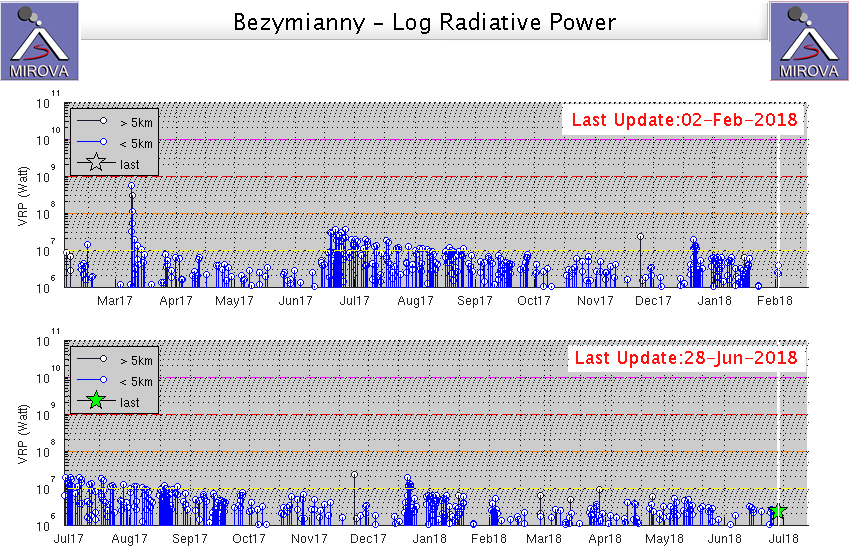Report on Bezymianny (Russia) — July 2018
Bulletin of the Global Volcanism Network, vol. 43, no. 7 (July 2018)
Managing Editor: Edward Venzke.
Research and preparation by Robert Andrews.
Bezymianny (Russia) Ongoing low-level thermal anomalies during January-June 2018
Please cite this report as:
Global Volcanism Program, 2018. Report on Bezymianny (Russia) (Venzke, E., ed.). Bulletin of the Global Volcanism Network, 43:7. Smithsonian Institution. https://doi.org/10.5479/si.GVP.BGVN201807-300250
Bezymianny
Russia
55.972°N, 160.595°E; summit elev. 2882 m
All times are local (unless otherwise noted)
Activity at Bezymianny has been frequent over the past 60 years, and almost continuous since May 2010. The Kamchatka Volcanic Eruptions Response Team (KVERT) reported that ash plumes from the 20 December 2017 explosive eruption (BGVN 43:01) rose as high as 15 km and drifted 320 km NE (figure 24). On 29 December activity included moderate gas-and-steam emissions; a lava flow likely continued to effuse onto the N flank of the lava dome. A thermal anomaly over the volcano was identified in satellite images in late December 2017.
 |
Figure 24. Explosions from Bezymianny sent ash plumes up to 15 km altitude on 20 December 2017. Photo by Yu. Demyanchuk; courtesy of IVS FEB RAS, KVERT. |
KVERT reported on 5 April 2018 that moderate gas-and-steam activity was continuing. Satellite data showed a thermal anomaly over the volcano on 29-30 March and 2-3 April, but the volcano was obscured by clouds in the other days of week. Fumarolic plumes were also seen on 13 April (figure 25). No MODVOLC thermal alerts were measured during the first half of 2018, and MIROVA analysis shows only low level radiative power anomalies for the same period (figure 26).
 |
Figure 25. Thermal anomalies at Bezymianny recorded by the MIROVA system (log radiative power) for the year ending 2 February 2018 (top) and 28 June 2018 (bottom). Courtesy of MIROVA. |
 |
Figure 26. Thermal anomalies at Bezymianny recorded by the MIROVA system (log radiative power) for the year ending 28 June 2018. Courtesy of MIROVA. |
Geological Summary. The modern Bezymianny, much smaller than its massive neighbors Kamen and Kliuchevskoi on the Kamchatka Peninsula, was formed about 4,700 years ago over a late-Pleistocene lava-dome complex and an edifice built about 11,000-7,000 years ago. Three periods of intensified activity have occurred during the past 3,000 years. The latest period, which was preceded by a 1,000-year quiescence, began with the dramatic 1955-56 eruption. This eruption, similar to that of St. Helens in 1980, produced a large open crater that was formed by collapse of the summit and an associated lateral blast. Subsequent episodic but ongoing lava-dome growth, accompanied by intermittent explosive activity and pyroclastic flows, has largely filled the 1956 crater.
Information Contacts: Kamchatka Volcanic Eruptions Response Team (KVERT), Far Eastern Branch, Russian Academy of Sciences, 9 Piip Blvd., Petropavlovsk-Kamchatsky, 683006, Russia (URL: http://www.kscnet.ru/ivs/kvert/); Institute of Volcanology and Seismology, Far Eastern Branch, Russian Academy of Sciences (IVS FEB RAS), 9 Piip Blvd., Petropavlovsk-Kamchatsky 683006, Russia (URL: http://www.kscnet.ru/ivs/eng/); Hawai'i Institute of Geophysics and Planetology (HIGP) - MODVOLC Thermal Alerts System, School of Ocean and Earth Science and Technology (SOEST), Univ. of Hawai'i, 2525 Correa Road, Honolulu, HI 96822, USA (URL: http://modis.higp.hawaii.edu/); MIROVA (Middle InfraRed Observation of Volcanic Activity), a collaborative project between the Universities of Turin and Florence (Italy) supported by the Centre for Volcanic Risk of the Italian Civil Protection Department (URL: http://www.mirovaweb.it/).

